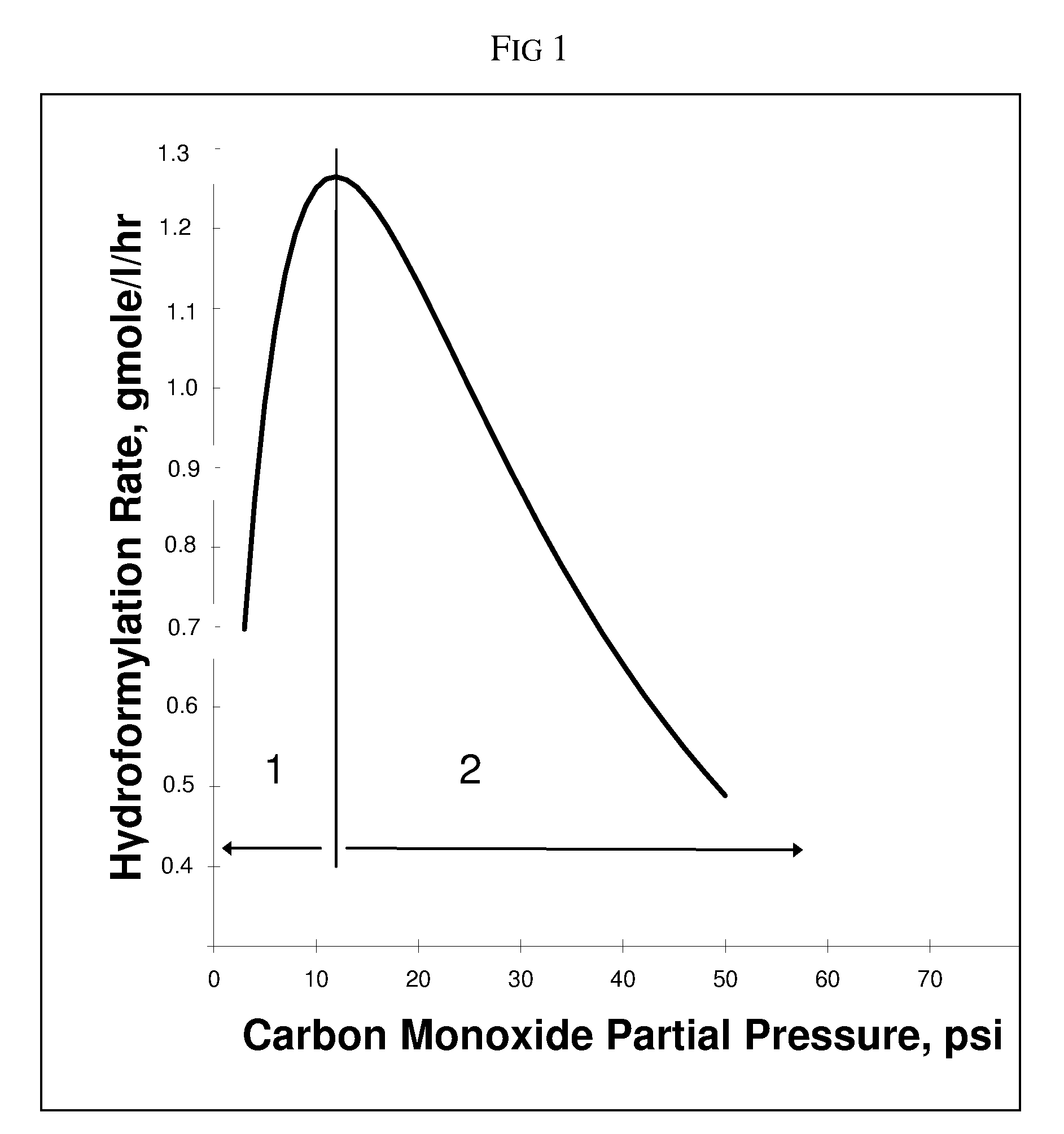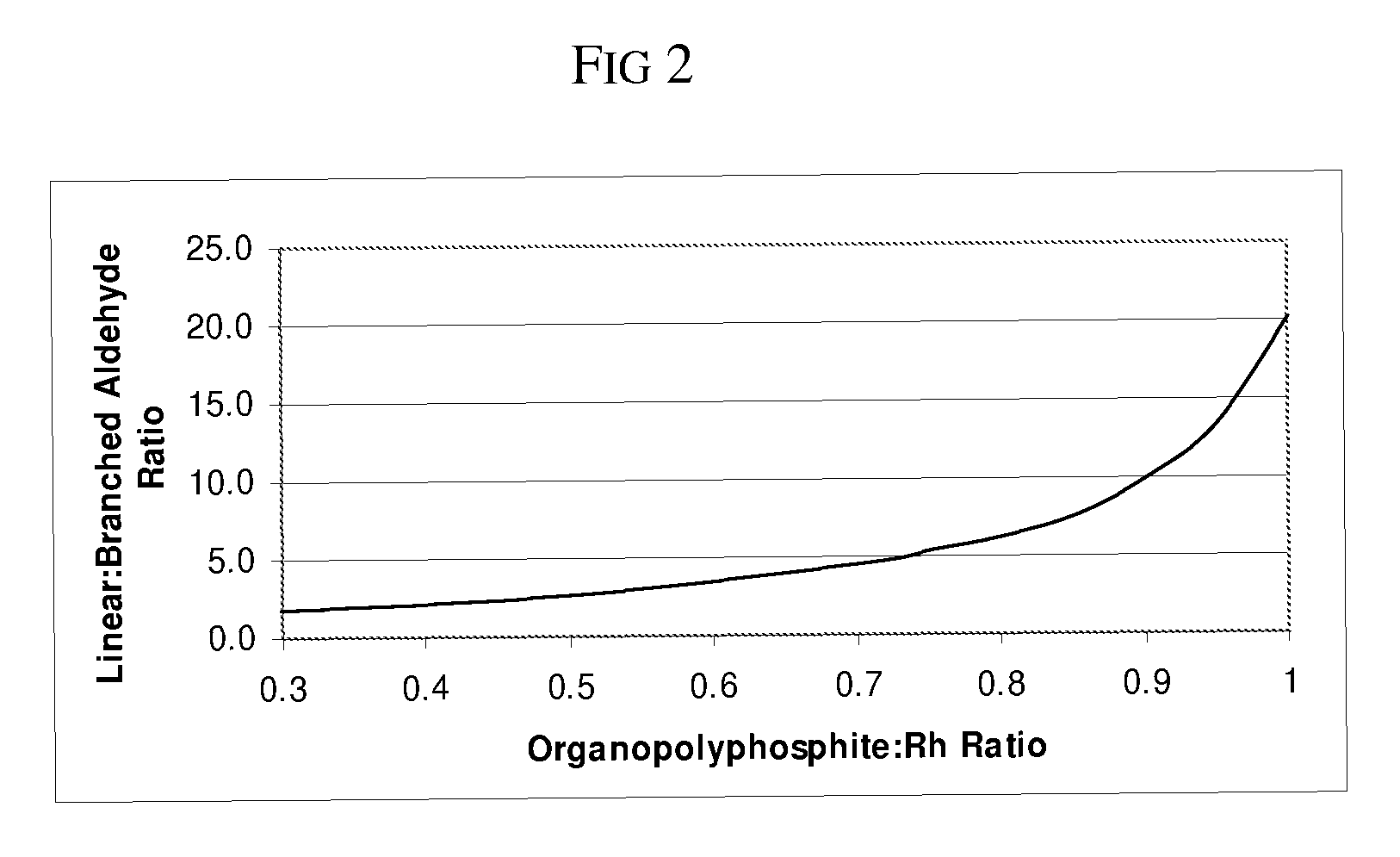Hydroformylation process with improved control over product isomers
a technology of hydroformylation and product isomers, which is applied in the field of improved process for hydroformylation of olefinically unsaturated compounds, can solve the problems of inability to obtain acceptable process productivity, inability to convert a manufacturing site from one catalyst to another, and inability to achieve acceptable process productivity, etc., to achieve acceptable productivity, reduce metal and ligand concentration, and simplify operation
- Summary
- Abstract
- Description
- Claims
- Application Information
AI Technical Summary
Benefits of technology
Problems solved by technology
Method used
Image
Examples
control example 1
[0135]Using the general process procedure described hereinabove, a hydroformylation reactor is loaded with a catalyst comprising rhodium (115 ppm, as rhodium dicarbonyl acetylacetonate) and tris(2,4-di-tert-butylphenyl) phosphite (0.72 weight percent in reaction fluid comprising tetraglyme) for a Ligand / Rh molar ratio of 10. H2 and CO partial pressures are maintained at 30 psi (207 kPa) each (the remainder being N2 and propylene). Propylene flow is sufficient to give a hydroformylation rate of 1 gmol / l / hr (Rate(mono)). The aldehyde product is analyzed every 4 hours as described above. The N / I isomer ratio is calculated over a running 5 day average (i.e., average of previous 5 days) for nearly one month with the results shown in Table 2.
[0136]
TABLE 2Control using Organomonophosphite LigandN / IDay5 day average50.86100.87150.89200.87250.88
Table 2 demonstrates the performance of a Rh-organomonophosphite ligand complex catalyst system, in the absence of organopolyphosphite ligand. Under t...
control example 2
[0137]Following the general process procedure hereinabove, a reactor is charged with rhodium (100 ppm) and organopolyphosphite Ligand D hereinabove (0.24 wt percent in the reaction fluid) for a Ligand / Rh molar ratio of 3:1. The H2 and CO partial pressures are maintained at 30 psi (207 kPa) each (the remainder being N2 and propylene). From a previous study of hydroformylation reaction rate versus CO partial pressure, it is found that 30 psi (207 kPa) CO partial pressure falls within the negative order region of the hydroformylation rate curve (Refer to FIG. 1). Under reaction conditions, the average hydroformylation rate is 0.9 gmol / l / hr (Rate(poly)), measured as a daily running average. The aldehyde product is analyzed every 4 hours as described above. The N / I isomer ratio is calculated over a running daily average for 8 days with the results shown in Table 3.
[0138]
TABLE 3Control Using Organopolyphosphite LigandN / IDayDaily average122438540639738834
Table 3 demonstrates the performanc...
example 1
[0140]A hydroformylation process is conducted in accordance with the general procedure described hereinabove. A target N / I isomer ratio is set at 4.0 and Equation 3 and FIG. 2 are used to estimate an initial molar ratio (Xopp) of organopolyphosphite ligand:Rh of 0.7 / 1. The catalyst solution comprises rhodium (115 ppm), tris(2,4-di-tert-butylphenyl)phosphite (0.7 wt percent based on reaction fluid) for an organomonophosphite:Rh molar ratio of 10:1, and organopolyphosphite Ligand D (0.07 wt percent based on reaction fluid) for an initial molar ratio of Ligand D:Rh of 0.8 / 1 (Xopp) (which is slightly high to allow for some oxidation) in tetraglyme. Using Ligand D and propylene, CO partial pressures in the negative order region of the hydroformylation rate curve are pre-determined per the method described in WO-2006-020287 and summarized hereinabove, resulting in FIG. 1. A pressure of 30 psi (207 kPa) is determined to lie in the negative order region of the rate curve and is used in this...
PUM
| Property | Measurement | Unit |
|---|---|---|
| molar ratio | aaaaa | aaaaa |
| temperature | aaaaa | aaaaa |
| temperature | aaaaa | aaaaa |
Abstract
Description
Claims
Application Information
 Login to View More
Login to View More - R&D
- Intellectual Property
- Life Sciences
- Materials
- Tech Scout
- Unparalleled Data Quality
- Higher Quality Content
- 60% Fewer Hallucinations
Browse by: Latest US Patents, China's latest patents, Technical Efficacy Thesaurus, Application Domain, Technology Topic, Popular Technical Reports.
© 2025 PatSnap. All rights reserved.Legal|Privacy policy|Modern Slavery Act Transparency Statement|Sitemap|About US| Contact US: help@patsnap.com



